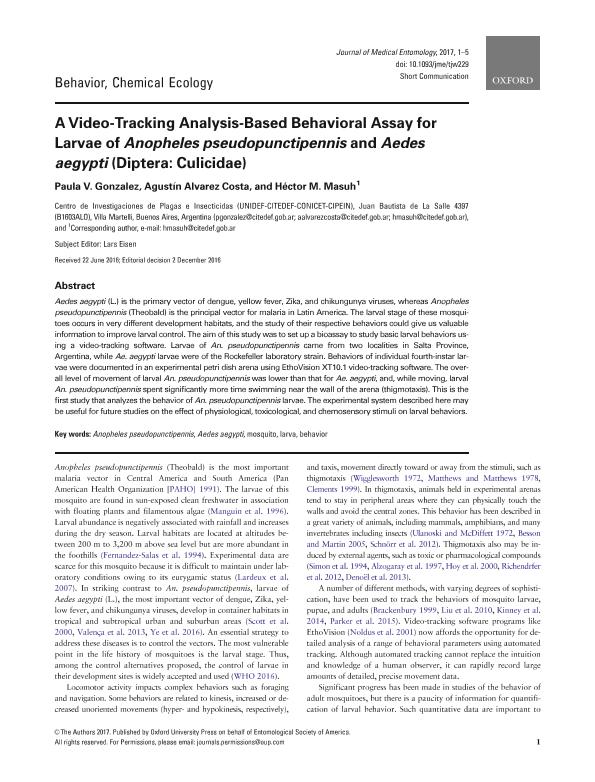Artículo
A Video-Tracking Analysis-Based Behavioral Assay for Larvae of Anopheles pseudopunctipennis and Aedes aegypti (Diptera: Culicidae)
Fecha de publicación:
02/2017
Editorial:
Entomological Society of America
Revista:
Journal of Medical Entomology
ISSN:
0022-2585
Idioma:
Inglés
Tipo de recurso:
Artículo publicado
Clasificación temática:
Resumen
Aedes aegypti (L.) is the primary vector of dengue, yellow fever, Zika, and chikungunya viruses, whereas Anopheles pseudopunctipennis (Theobald) is the principal vector for malaria in Latin America. The larval stage of these mosquitoes occurs in very different development habitats, and the study of their respective behaviors could give us valuable information to improve larval control. The aim of this study was to set up a bioassay to study basic larval behaviors using a video-tracking software. Larvae of An. pseudopunctipennis came from two localities in Salta Province, Argentina, while Ae. aegypti larvae were of the Rockefeller laboratory strain. Behaviors of individual fourth-instar larvae were documented in an experimental petri dish arena using EthoVision XT10.1 video-tracking software. The overall level of movement of larval An. pseudopunctipennis was lower than that for Ae. aegypti, and, while moving, larval An. pseudopunctipennis spent significantly more time swimming near the wall of the arena (thigmotaxis). This is the first study that analyzes the behavior of An. pseudopunctipennis larvae. The experimental system described here may be useful for future studies on the effect of physiological, toxicological, and chemosensory stimuli on larval behaviors.
Palabras clave:
Anopheles Pseudopunctipennis
,
Aedes Aegypti
,
Mosquito
,
Larva
,
Behavior
Archivos asociados
Licencia
Identificadores
Colecciones
Articulos(UNIDEF)
Articulos de UNIDAD DE INVESTIGACION Y DESARROLLO ESTRATEGICOS PARA LA DEFENSA
Articulos de UNIDAD DE INVESTIGACION Y DESARROLLO ESTRATEGICOS PARA LA DEFENSA
Citación
Gonzalez, Paula Valeria; Alvarez Costa, Agustin; Masuh, Hector Mario; A Video-Tracking Analysis-Based Behavioral Assay for Larvae of Anopheles pseudopunctipennis and Aedes aegypti (Diptera: Culicidae); Entomological Society of America; Journal of Medical Entomology; 54; 3; 2-2017; 793-797
Compartir
Altmétricas




